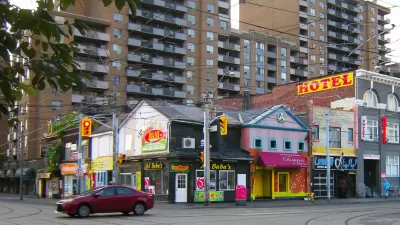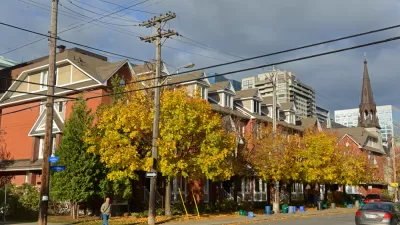In the fifty years since Jane Jacobs introduced the "eyes on the street" theory, it's become a commonly accepted conceit that a mix of use reduces crime. A new study calls that theory into question.
"Jane Jacobs 'had it backwards,' according to a report in this month’s University of Pennsylvania Law Review."
Matt Bevilacqua discusses the findings reported by researchers from RAND, the University of Pennsylvania, and the University of Southern California.
"Focusing on more than 200 blocks in eight high-crime Los Angeles neighborhoods, the report found that areas zoned for mixed-use development had lower crime rates than those zoned for commercial uses only. Areas purely made up of residences, however, had lower crime rates than either."
“[W]e find that residential zoning is associated with substantially lower crime than commercial zoning or mixed-use zoning,” the researchers write, later adding, “With respect to natural surveillance, we find no support for Jacobs’s argument that commercial uses will reduce crime by encouraging a robust street life and ‘eyes on the street.’”
"The report also notes that assaults, robberies, thefts and burglaries decreased when residential housing was introduced into single-use commercial zones," adds Bevilacqua. "These crimes increased, however, when businesses were introduced into residiential-only [sic] areas, backing up the notion, for one, that a 'place of business in a residence neighborhood furnishes an excuse for any criminal to go into the neighborhood.'”
"The authors do stress the need for further research on the built environment before drawing any definitive conclusions about its effect on crime rates," he concludes. "So it will take more evidence before we can heed the suggestion that new urbanists have been mixing it up all these years."
FULL STORY: Researchers Challenge Jane Jacobsian Notion that “Eyes On the Street” Reduce Crime

Maui's Vacation Rental Debate Turns Ugly
Verbal attacks, misinformation campaigns and fistfights plague a high-stakes debate to convert thousands of vacation rentals into long-term housing.

Planetizen Federal Action Tracker
A weekly monitor of how Trump’s orders and actions are impacting planners and planning in America.

San Francisco Suspends Traffic Calming Amidst Record Deaths
Citing “a challenging fiscal landscape,” the city will cease the program on the heels of 42 traffic deaths, including 24 pedestrians.

Defunct Pittsburgh Power Plant to Become Residential Tower
A decommissioned steam heat plant will be redeveloped into almost 100 affordable housing units.

Trump Prompts Restructuring of Transportation Research Board in “Unprecedented Overreach”
The TRB has eliminated more than half of its committees including those focused on climate, equity, and cities.

Amtrak Rolls Out New Orleans to Alabama “Mardi Gras” Train
The new service will operate morning and evening departures between Mobile and New Orleans.
Urban Design for Planners 1: Software Tools
This six-course series explores essential urban design concepts using open source software and equips planners with the tools they need to participate fully in the urban design process.
Planning for Universal Design
Learn the tools for implementing Universal Design in planning regulations.
Heyer Gruel & Associates PA
JM Goldson LLC
Custer County Colorado
City of Camden Redevelopment Agency
City of Astoria
Transportation Research & Education Center (TREC) at Portland State University
Jefferson Parish Government
Camden Redevelopment Agency
City of Claremont





























